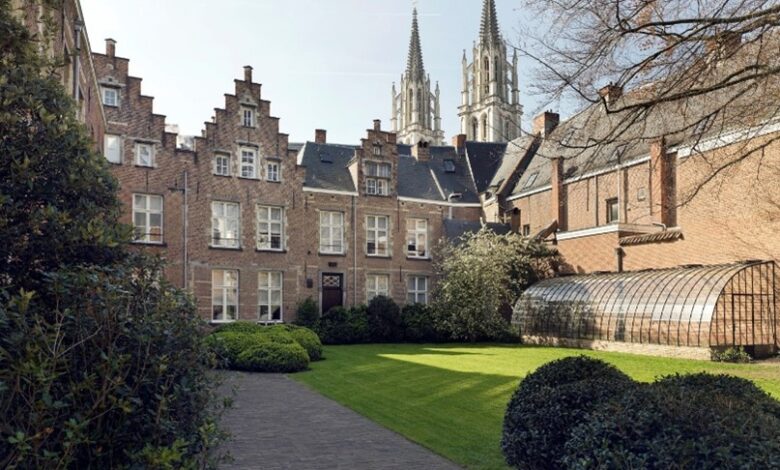
Botanic Sanctuary Antwerp as a Culinary Capital and a Historic Hotel, Part 1
By Larry and Adam Mogelonsky | September 23, 2025
We are what we eat. For the longest time, this universal motto has pertained only to how diet influences health. Now, it also embodies the epicurean traveler. We are where we travel to eat.
Long before Anthony Bourdain and his ilk started documenting their gastronomic travels to the modern traveler and the coining of related terms like “garden to fork,” “foodies,” or even “slow travel,” we had the agriturismos dotting the Italian countryside, printed Michelin guidebooks for vacationers driving Europe’s back roads in search of a great meal, and a select number of associations that have helped bring hospitality’s numerous hotbeds of F&B excellence to the world stage. The point is: purposefully traveling to dine or expecting accommodations to deliver magnificent meals as a complement to another purpose has existed for generations.
Only now, however, this trend has exploded. Hotels, restaurants and their incredibly imaginative chefs are all locked in a grand, global competition to delight their guests with delectable dishes that are exquisitely presented and tell the story of the land. How does any place stand apart?
About Botanic Sanctuary Antwerp
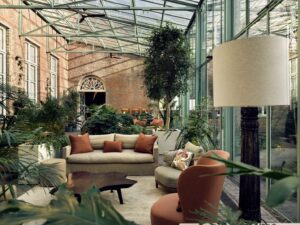 With its 108 rooms, including 16 suites, Botanic Sanctuary Antwerp is the answer to this question. Opened in 2021, the luxury hotel and member of Leading Hotels of the World is not only a marvelous architectural restoration of a campus of medieval buildings going as far back as the early 1200s — including a monastery, hospital, apothecary, and chapel —it’s transformed the premises into a veritable culinary mecca.
With its 108 rooms, including 16 suites, Botanic Sanctuary Antwerp is the answer to this question. Opened in 2021, the luxury hotel and member of Leading Hotels of the World is not only a marvelous architectural restoration of a campus of medieval buildings going as far back as the early 1200s — including a monastery, hospital, apothecary, and chapel —it’s transformed the premises into a veritable culinary mecca.
Of Botanic Sanctuary Antwerp’s five restaurants, one has one Michelin star (Fine Fleur by Chefs Jacob Jan Boerma and Thomas Diepersloot) while the signature outlet, Hertog Jan by longstanding partners Chef Gert De Mangeleer and host Joachim Boudens, has two stars. Both are also highly acclaimed by Gault Millau and other food-centric guides, singlehandedly propelling the city’s culinary scene onto the world stage. Rounding out these haute cuisine hotspots are Henry’s Bistro, Henry’s Bar, and Bar Bulot, where together all five outlets offer near endless options for travelers and locals alike.
And to fulfill its namesake as a botanical haven, gardens and greenhouses are intermixed amongst the public corridors and guestroom areas where sustainable agriculture practices provide many of the seasonally rotated ingredients for the onsite restaurants. Alongside its biophilic design, guests can walk the grounds to see how the herbs, honey, flowers, and staple vegetables of Benelux go from the farm to fork in real time.
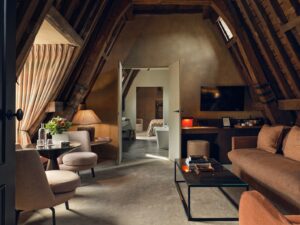 By having so many signature restaurants and onsite farming in one place, the hotel has become a destination unto itself. This is much the same strategy that the best casino resorts in Las Vegas now have taken by offering over two dozen world-class dining concepts so that there’s always something exciting. Only here, the culinary leadership at Botanic Sanctuary Antwerp has set out to immerse guests in the story of modern Belgian cuisine, while also engaging guests at every turn with historic restorations architecture from the Middle Ages.
By having so many signature restaurants and onsite farming in one place, the hotel has become a destination unto itself. This is much the same strategy that the best casino resorts in Las Vegas now have taken by offering over two dozen world-class dining concepts so that there’s always something exciting. Only here, the culinary leadership at Botanic Sanctuary Antwerp has set out to immerse guests in the story of modern Belgian cuisine, while also engaging guests at every turn with historic restorations architecture from the Middle Ages.
Altogether, Botanic Sanctuary Antwerp tells the story that food is not just sustenance; it’s a conversation with the culinary team, with the ingredients, with the region, with the local culture. This is a foundational principle for how hotels can approach and elevate their culinary presentation that wins over guests every time, and yet it require a tireless dedication to execute properly.
Hence, it was a joyous occasion to sit down with Chef Gert De Mangeleer, one half of the innovative leadership behind the two-Michelin-star Hertog Jan, to learn about the process in crafting this culinary capital.
The thoughtful comments from Chef De Mangeleer are coming fresh off the line from the recent Botanic Gourmet Festival. This event featured all resident chefs as well as a full slate of distinguished international additions — Viki Geunes (Zilte), Christian Kuchler (Taverne zum Schäfli), Hans Neuner (Ocean Restaurant), Sidney Schutte (Spectrum), Dieter Koschina (Vila Joya), Alexandre Gauthier (La Grenouillère), and Alberto Landgraf (Oteque) — for a series of four- and six-hands lunches and dinners as well as high tea takeovers, exclusive tastings, and gastronomic masterclasses.
MOGELONSKY HOTEL CONSULTATIONS: What would you say defines modern Belgian cuisine? What has been your approach to bringing the ingredients and gastronomy of Belgium to the world stage?
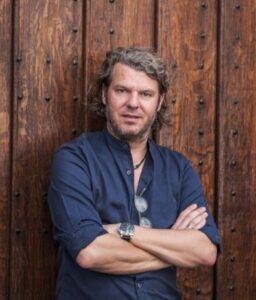
GERT DE MANGELEER: It is indeed true that in the Botanic Sanctuary hotel several angles of what top hospitality should be come together seamlessly. The F&B aspect is certainly an essential part of that and the conversation around joining forces with Botanic Sanctuary came at an ideal time. We had stopped in 2018 at a high point with almost 10 years of three stars behind our name when the hotel approached us. The first idea was to open a second branch of Bar Bulot, but in the second instance the question also came as to whether or not we wanted to do something gastronomic again.
At that time, we weren’t working on it ourselves, but the desire was there. Parallel to the whole hotel story, we have also seen a shift in the culinary landscape in Belgium in recent years; where 15 years ago, Bruges and the surrounding area was the mecca of gastronomic Belgium, this is now undoubtedly Antwerp. The city has increasingly established itself as a premier culinary hotspot, marked by the arrival of The World’s 50 Best in 2021 and the launch of the new Michelin Guide to Antwerp last year. Add to that the stunning setting of Botanic Sanctuary, alongside Antwerp’s renowned shopping, diamond district, and museums, and you have an exceptionally appealing destination for a memorable city getaway.
MHC: In late 2018, the original Hertog Jan — first in Sint-Michiels, a suburb of Bruges, then in Zedelgem, slightly further southwest of the city — closed after 16 years, likely coming as a shock to many who had grown to love the acclaimed restaurant. Such decisions don’t come lightly at all. How do you know when it’s time to move on?
GDM: When we announced that we would close our gastronomic restaurant at a peak, it came as a bombshell. People did not understand why because at that time we had had our three Michelin stars for almost a decade. We had started small in 2002 in a brown café that Joachim and I transformed step by step into a gastronomic restaurant. From day one, our “secret” boyhood dream was to one day achieve three stars. We had known each other for a few years and had once sealed this dream in the early hours at a café a few years before. Another part of our dream was also to stop at a high point. And we did this.
Of course, this decision was not simple. We had worked on our dream for all those years, moved to our new location in 2014, which was completely custom built for what we wanted to use it for, and then it is surprising to stop four years later with a brand-new restaurant and three stars behind your name.
In those first years of the move, you are still busy fine-tuning and getting to know the new location. But after two years, I started traveling more and I regularly did collaborations and four-hand dinners with other chefs. I got a lot of satisfaction from that, but Joachim always stayed in Zedelgem because we think it is important that one of us can always welcome and speak to our guests. At a certain point he asked himself the question: What now? We had three stars, the restaurant was doing well, and we did not immediately see a next step with Hertog Jan, and the idea started to mature to stop with the gastronomic restaurant.
We had gotten into a certain routine that we didn’t like, and because of the size of the restaurant it had also become more difficult to quickly change a menu last-minute, which also limited my creativity. We made the decision to stop and focus on new projects, and that created space to develop L.E.S.S. Eatery/Bar Bulot and Babu. The thing is that you have to keep enjoying what you do. If this is no longer the case, then it’s time for a change. This does not always mean that you have to stop, but then it is time to stand still and think about how you can reinvent yourself to some extent.
MHC: The dining experience at the two-Michelin-starred Hertog Jan is described as “Belgian omakase,” yet this phrasing belies decades of study and dedication to artful precision in every dish. Tell us about the challenges you overcame in launching this restaurant (and Bulot’s second location) and in attaining its two stars within seven months of opening.
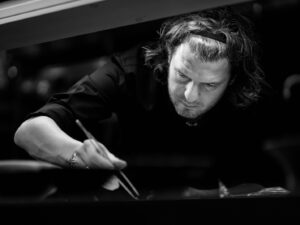
GDM: My track record goes back a long way. I have been a chef at the highest level for 25 years and have had an enormous dedication from day one when it comes to purchasing top products, processing them correctly and precisely, and then of course my creative approach to preparing them. Over the years, my interest in Japan grew and I have been there about 30 times to train myself but also often to cook four-handed dinners with my Japanese colleagues.
In this way, I gradually developed my own omakase style. This development also came at the same time as the move from the rural Zedelgem to the vibrant cosmopolitan atmosphere of Antwerp. Where at that time the focus was mainly on the vegetables, herbs, and flowers that we grew in our own garden, there was now more room for the Japanese influences because they fit in perfectly with all the worldly influences that come together in a vibrant port city like Antwerp.
The whole process of purifying my style came quite naturally. What has certainly also been a big plus in this evolution is the fact that I once had three years of not being involved in gastronomy and completely letting go of what Hertog Jan was at the time, creating space for new ideas that allow me to look neutrally at what has been, what was good, what was less, and which direction to go. This would never have succeeded if a running business was in the way because it demands all of our attention every day.
At the reopening, we did not know what to expect from Michelin. I had already had three stars behind my name for almost a decade and had informed them about our new plans, but how they would rate the new concept with one omakase menu, small occupancy, and limited opening hours was a mystery. In the end, I was very satisfied when we immediately made our comeback with two stars behind our name. This entire process has and continues to challenge us in a positive way. Sometimes in the sports world you hear about making a comeback, and we had a bit of this feeling ourselves with the reopening of Hertog Jan in Antwerp.
As mentioned, there was no Hertog Jan for a three-year period and this was when I focused on my other projects. One of them was Bar Bulot where I wanted to serve classic French-Belgian dishes in the setting of a vibrant brasserie. The test case of our Bar Bulot concept is located in Zedelgem and there I have continued to tinker with the concept in order to optimize all processes so that a clear script was created. Because this concept was already so far developed, it was easier in a way to open a second branch of it. There were quite a few practical issues that we had already encountered in the test phase that were now simple to tackle. Choices for house style and interior design were also already made, which allowed us to open a new restaurant in a much more efficient and peaceful way. And we were lucky enough to have chef Koen Gussenhoven and restaurant manager Elske Mostert at our side throughout this entire process.
In part 2 of our conversation with Chef Gert De Mangeleer, we’ll learn about the importance of having a diverse range of dining styles and concepts at Botanic Sanctuary; the significance of training in the rapidly changing hospitality world; and how “food as medicine” is embraced in the culinary presentation at Botanic Sanctuary.





Get involved!
Comments